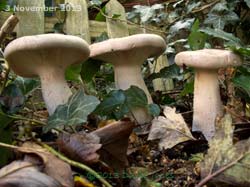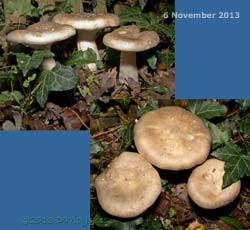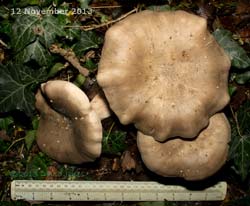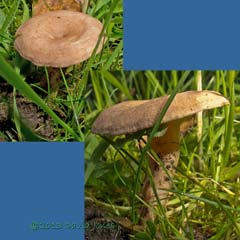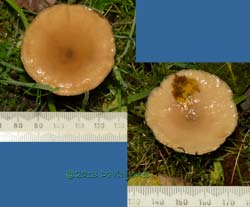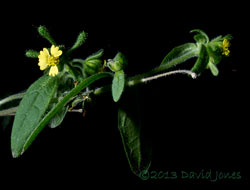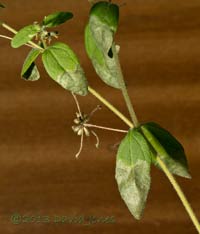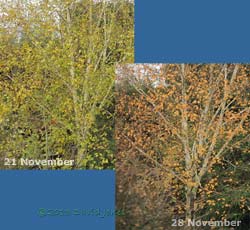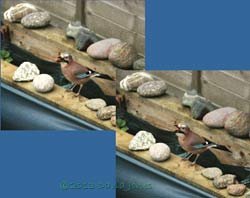Go to the last entry on this page .....Go to previous entry
12 November - November got off to a less than auspicious start, with our grandson plagued by several infections (all of which have now cleared, after a rotten cold was passed on to Grandma!). He is now back to his happy, lively self, and Grandma is getting better. In the garden, acorns that were collected during walks in the local park at the end of last month were placed on top of the soil in a planter, in the hope that some would germinate. However, we now need to collect some more. A week ago I happened to look out of our bedroom window as a Jay visited the planter and flew off with one. By today a dozen or so acorns had disappeared. While I can't be sure that the Jay took them all, I think there is a good chance that it was responsible. I will probably head for the park tomorrow to replenish our stocks.
At the beginning of the month I spotted this trio of quite substantial fungal fruiting bodies in the shade of the Cotoneaster. On the 3rd the largest, in the middle of the group, measured around 9cm across the cap.
Three days later and it was nearer 13cm across.
By this evening it has grown to about 20cm across, and two others (out of picture) were also in excess of 15cm across. This is the first time that I've seen a group of such large fruiting bodies in the garden. As usual, identifying fungi is not something that I have any confidence about, but this one does strongly resemble the Clouded Agaric (Clitocybe nebularis).
Scattered along the bank of the big pond there are a number of smaller fruiting bodies (unidentified) This one was photographed on the 3rd,
and these this evening. The one on the left is the largest that I could see, at around 4.6cm across.
There are still two species of flowering plants producing blossoms in the garden, White Dead Nettles and Red Campions, and in the house our alien plant continues to surprise up with more of its yellow flowers - ten new ones in the last two days.
Overall, the plant is now looking rather worst for wear, with many of its older leaves showing their age as their tissues break down, starting at the apex of each leaf. However, as both pictures show, along with the new flowers there are also young leaves that look healthy. I really must make a renewed effort to identify the plant so that I can give it a name by the end of the year!
28 November - As we approach the end of the month the skies have remained for much of the time a glum sort of grey, although with no more than a hint of dampness. There have been just a couple of frosty starts since the previous entry, and these have provided opportunities for little Evan to do a bit of moon watching, leaning out of our bedroom window - he is even takes some pride in drawing moons these days! When my eldest son was small, at the time of the Apollo trips to the moon, we had a lovely inflatable moon. I've been looking for one to get for Evan but without luck so far - it seems that the moon is out of fashion.... I've just spent the first part of the evening watching the 'near live' satellite images being posted from NASA's Solar Dynamics Observatory spacecraft as Comet Ison made its close pass of the sun. While the images show incredible details of the sun' surface it seems that Ison took too close a 'look' and paid the ultimate price. A bit like the English cricket team, after a great deal of promise (and perhaps a generous dose of hype) it failed to stand up to the heat of that first (and only) encounter. So there will be no early starts on a cold December morning as I try to photograph the 'Comet of the Century'..... Back to the garden, and a bit of good news, although with a touch of disappointment - the mystery plant is a mystery no more. It is Sigesbeckia Orientalis, known by a variety of common names including Eastern St. Paul's Wort, and probably a native of South-east Asia, although it is also found in Africa, Australia, South America and has also spread to many parts of the world, including the USA and the UK. Described as a small, ugly weed, it nevertheless has a place in traditional medicine as a treatment for conditions such as syphilis, leprosy and other skin diseases. In China its sap has long been used to treat rheumatic pains. Our plant has now stopped producing flowers and seed production has also almost come to an end. I must thank Mike (who often comes to my assistance in matters grammatical!) for pointing me in the direction of an excellent website iSpot run by the Open University. This is a site where you are able to share your wildlife observations with an international community who are clearly ready to help with problems like mine. Initially I had avoided posting pictures to the site as I wanted to track the plant's ID down myself. However, with the plant coming to the end of its flowering I headed there with some reluctance (and I suppose a sense of defeat) and within a couple of hours the plant was identified.
Autumn has finally caught up with our Himalayan Birch. A week ago its leaves were still largely green, but today they are decidedly autumnal, and below the tree the path is hidden by a carpet of leaves.
In the previous entry I mentioned that a Jay was taking acorns from the garden. It was here again today, returning numerous times to take acorns from the same planter. By today the acorns had germinated and were split, which was perhaps not a bad thing as on several visits the Jay swallowed the acorn before leaving.
After taking a few pictures from our bedroom at an acute angle through rather dirty double glazing, I set the camera up on the veranda, with a wireless remote so I could watch from the bedroom. Unfortunately it didn't return. I may try that arrangement again tomorrow morning.
Click on images to see larger versions
|
|
